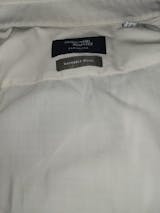D|Duffle Coats, Down Vests, Desert Boots and Denim
Style is life! It is the very life-blood of thought!
-Gustave Flaubert
Duffle coats, Down vests, Desert boots and Denim
What originally started out as standard-issue military clothing has over the years evolved into some of the best, most well made items of civilian clothes you can buy. Some time ago I owned an expensive duffle coat, however it was over engineered, fussy and had lost some of its original, simple utilitarian functionality. Eventually I gave it away and bought a basic Gloverall duffle called 'The Monty', named after the famous Second World War leader, Field Marshall Bernard Montgomery. It's a very fine, acceptable addition to my Ivy wardrobe.
The confidence that comes from being well-dressed is immeasurable
In the Belgian town of Duffel (now part of Antwerp) a heavy woolen cloth with a high lanolin content that makes it naturally water repellent had been woven since the Middle Ages. No surprise then that this fabric was eventually picked up by the Royal Navy and turned into the ubiquitous duffle coat that we know today. The original duffle coat made by Gloverall was an oversized coat worn by British sailors over their uniforms. In 1951 Gloverall sold their surplus from the Second World War and the Korean War. These surplus duffle coats quickly spread to most countries that had cold winters. They soon became the topcoat of choice for British students and ironically, political radicals. In France, Parisian Left Bank Existentialists wore the duffle coat as a symbol of anti-bourgeoise sentiment. In American it was the opposite: duffle coats were strictly collegiate affairs and no Ivy League student would leave home without one, often continuing to wear the coat long after university. Many companies now make duffle coats but the original model made by Gloverall is the benchmark. Actor, James Stewart was a fan and John F Kennedy wore a duffle coat for sailing during winter. The duffle coat is the ultimate signifyer of the Ivy look in cold weather
The boot that kick-started a thousand scooters. Seventy years ago Nathan Clark gave to the world the timeless Clark's Desert Boot. He modeled it on a type of boot made in the bazaars of Cairo and worn by off-duty British Army officers. In the 1960s from American university campuses to the streets of Soho inhabited by London Mods, it was the only boot to be seen in. With it's uppers of smooth full-grain suede and plantation crepe soles it's a fine looking example of the shoemakers art and hits the spot when worn with a duffle coat and Levi's.
From cowboys to catwalks virtually everyone wears this hardwearing cotton twill fabric typically woven with a coloured warp and a white or underdyed weft and produced in a variety of weights. Indeed, this was the title of a book that I art directed and co-authored in 2002 which will tell you everything you want to know about denim. It's still available online. Originally denim was used to make protective workwear but now a high fashion favourite as well as an Ivy classic. Thought to be an abbreviation of the term 'Serge de Nimes,' A serge fabric from the city of Nimes in Southern France. The three main American players producing denim garments are Levis, Wrangler and Lee, there are also many companies in Japan making excellent classic denim products. That is a brief summation but I'll bet, indeed, am sure you are wearing a pair of denim jeans while reading this!
Down filled vests or Trail vests, as they are known in America are a useful addition to the Ivy pilgrims wardrobe. Due to it's lightweight and thermal properties, duckdown is ideal for lining these vests and jackets. Using a technique whereby two or more layers of fabric are sandwiched inbetween and joined together by lines of stitching - it's an Ivy look for all seasons.
An illustrations: Copyright Graham Marsh
Next up is the letter E: Eyewear - Espadrilles and Evening wear
About Graham Marsh
Graham Marsh is an art director, illustrator and writer. He has written and art directed many ground-breaking visual books including The Cover Art of Blue Note Records, volumes 1 and 2, East Coasting and California Cool. He has co-authored and art directed Denim: From Cowboys to Catwalks and a series of books with Tony Nourm and on movie posters. More recent books are The Ivy Look, Hollywood and the Ivy Look, Jazz Festival, The Beat Scene, French New Wave: A Revolution in Design and a 50th Anniversary volume on Woodstock plus a book on the early years of Ronnie Scott’s Jazz Club. He is author and illustrator of a children’s book called Max and the Lost Note. Marsh’s illustrations have appeared in magazines, newspapers and on many CD and album covers. He has contributed to numerous publications including Country Life and Financial Times.



